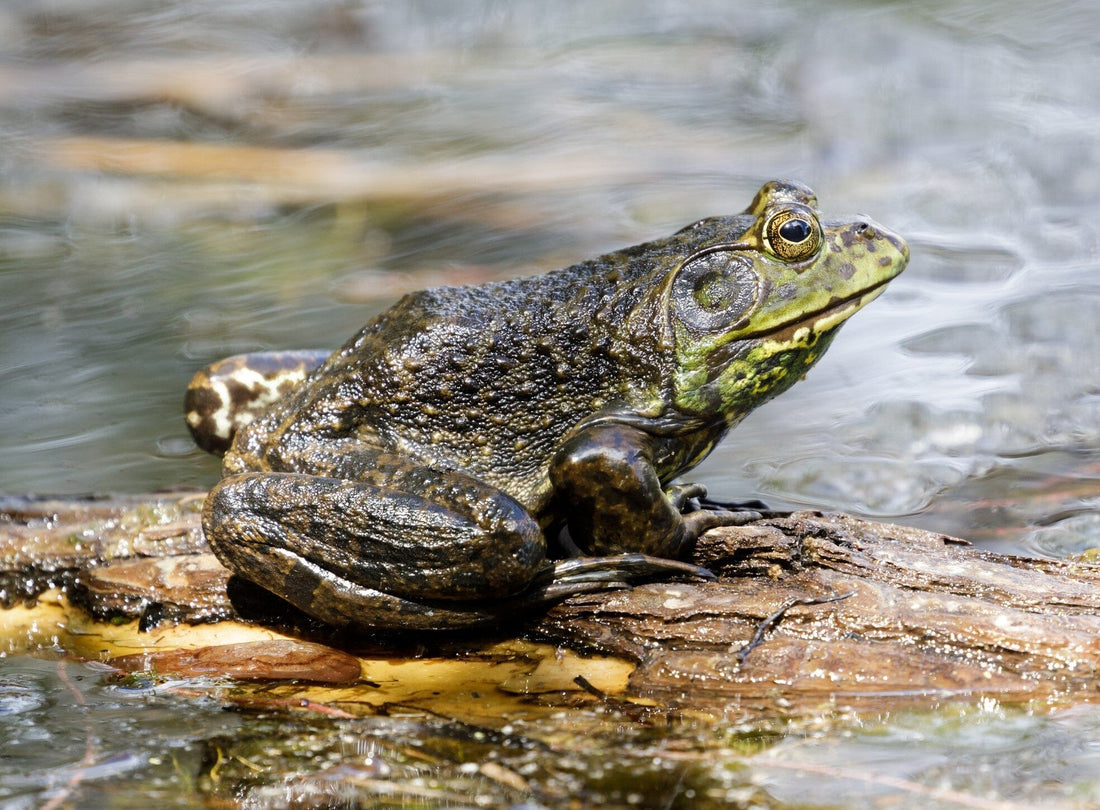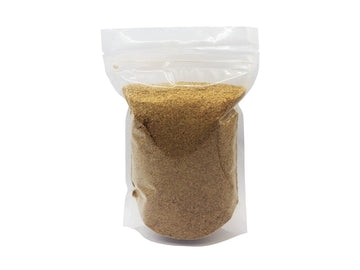American bullfrogs (Lithobates catesbeianus) are 3.5-6” long, semi-aquatic, diurnal frogs. They are native to eastern North America, but they are prolifically invasive in many other parts of the world, including South America, Europe, and Asia. Their preferred habitat is areas with warm, shallow water and plenty of aquatic vegetation.
American bullfrogs have large heads, stout bodies, short front legs, muscular long hind legs, and only their hind feet are webbed. Base color is usually olive green, and they may or may not have a mottled/banded gray-brown pattern. The belly is pale, and may be mottled yellow or gray.
American bullfrogs are considered advanced-level pet amphibians due to their large size, semi-aquatic nature, and sensitivity to inadequate husbandry. We do not recommend considering this species as a pet without a significant amount of research and preparation! However, when cared for well, they can live as long as 16 years.
Even if American bullfrogs are native/invasive to your area, never bring home a wild animal as a pet.
Recommended paludarium size for American bullfrogs
The recommended minimum terrarium size for a single American bullfrog is 48”L x 18”W x 21”H (75 gallons). Of course, larger is always better if you can manage it! American bullfrogs are incredibly powerful jumpers, and need plenty of space to exercise to maintain good condition.
Cohabitation (keeping multiple bullfrogs in one enclosure) is not recommended, as this species is well known for cannibalism.
Do American bullfrogs need UVB?
American bullfrogs seem to be able to survive fine without it, but we still recommend providing appropriate UVB lighting as part of the setup. UVB lighting helps provide a clear day/night cycle, provides all of the vitamin D that your pet needs, strengthens the immune system, facilitates better digestion, and provides other benefits. Plus, it’s quite likely that they are regularly exposed to sunlight in the wild, as American bullfrogs are primarily active during the day.
The best UVB bulbs for American bullfrogs housed in a 48” x 18” x 21” terrarium are:
For best results, house the UVB bulbs in a fixture with a reflector such as the Arcadia ProT5 Kit or the Zoo Med Reptisun Hood. Position the lamp on the same side of the terrarium as the heat lamp, about 13-15” above the basking platform if over mesh, and 16-18” above the basking branch if not.
Most people follow a 12-hour on and 12-hour off light schedule, but you can also follow the sun if you like! This means you can have more light during the summer and less light during the winter.
Best temperature for American bullfrogs
Like other amphibians, American bullfrogs are cold-blooded, which means that they rely on external temperatures to manage their own body temperature and metabolism. Although amphibians are generally not as dependent on thermal gradients as reptiles, it’s still important to make sure your frog can thermoregulate as needed.
American bullfrogs do best with a gentle “basking” temperature between 80-84°F. On the other side of the enclosure, the temperature is ideal around 74°F. This should also be the water temperature. Ambient temperatures can be measured with digital probe thermometers, one probe placed on each end. You can also measure basking and surface temperatures accurately with a temperature gun.
We suggest two low-wattage heat bulbs placed close together over the basking area to evenly heat the frog’s entire body. We do not recommend ceramic heat emitters (CHEs), red bulbs, or blue bulbs, as these are not as effective. If the bubs are a little too hot, you can use a rheostat or plug-in lamp dimmer to reduce output. If the bulbs are not hot enough, you would need a higher wattage.
Best humidity levels for American bullfrogs
As amphibians, American bullfrogs can’t live without ready access to water, especially when they’re still just tadpoles! Average air humidity is best around 60% during the day. Humidity can be measured via digital probe hygrometer, with the probe placed in the middle of the terrarium.
Given that American bullfrogs are semi-aquatic, most of the enclosure needs to be water. In other words, it is ideal to either place a large, removable tub of water inside the enclosure, or create a paludarium setup that functions like a shallow aquarium plus dry land.
If you go the water tub route, waste and debris should be removed daily, and the tub itself should be removed and scrubbed with animal-safe disinfectant once a week. The new water must be treated with dechlorinator before replacing — never used distilled or reverse-osmosis water for your frog!
If you turn the enclosure into a paludarium, you will want an appropriately-sized filter to keep the water clean, which requires specific routine maintenance of its own. Adding certain live aquatic plants can help maintain good water quality on top of the filter.
Since most of the enclosure is water, maintaining appropriate levels of humidity shouldn’t be an issue. However, if you notice that humidity levels have become too low for some reason, you can increase humidity by misting the enclosure with a spray bottle. A cool mist humidifier connected to a hygrostat can also help where needed.
Best substrate for American bullfrogs
Providing a thick layer of naturalistic substrate (“bedding”) will help maintain correct humidity levels and helps make your enclosure more attractive! We recommend the following substrates for American bullfrogs:
- Zoo Med ReptiSoil
- Zoo Med Eco Earth
- Exo Terra Plantation Soil
- Exo Terra Jungle Earth
The above recommendations are for the land portion of the enclosure. If you want substrate in the aquatic portion of the enclosure, fluorite and Exo Terra Riverbed Sand are both good options.
Remove poop and urates daily, along with contaminated substrate. We recommend replacing the substrate every 2 months if you are not running a bioactive setup.
How to decorate an American bullfrog paludarium
A bare enclosure makes for a bored frog, reducing its quality of life. Keep your pet entertained and engaged with its environment with the strategic use of décor items that encourage it to exercise natural behaviors!
Décor options for bullfrogs include:
- mopani wood
- cork bark
- rocks
- live or artificial plants
- pre-made hides/caves
Be sure your frog has covered areas to retreat to when it wants privacy.
What to feed to an American bullfrog
American bullfrogs are carnivorous, which means that they need to eat whole animal prey in order to get the right nutrition. Tadpoles and young bullfrogs should be fed daily, but adults should be fed 2-3x/week to prevent obesity.
(Although carnivorous as adults, American bullfrog tadpoles are actually herbivorous, eating algae and other aquatic plant material. Keep this in mind if you decide to raise your pet from the tadpole stage.)
Adult American bullfrogs are well known for their voracious diet, and will eat just about anything they can fit in their mouth, including other frogs. However, they prefer live prey, as they are attracted to movement.
Food options for American bullfrogs:
- Black soldier fly larvae
- Crawdads
- Crickets
- Discoid roaches
- Dubia roaches
- Earthworms
- Fish
- Hornworms
- Mealworms
- Mice
- Shrimp, whole
- Silkworms
- Snails (captive-bred only)
- Superworms
(Smaller bullfrogs are more likely to eat insects than larger bullfrogs.)
Supplements
We recommend you keep calcium and multivitamin supplements on hand to help prevent your pet from developing a nutritional deficiency and to help it live healthier. We recommend Repashy Calcium Plus LoD or Arcadia EarthPro RevitaliseD3, lightly dusted on prey before offering.
How to handle your American bullfrog
Amphibians generally don’t appreciate petting and handling in the same way that dogs and cats do, and American bullfrogs in particular are generally a hands-off pet. If you want to bond with your pet, try feeding them from soft-tipped feeding tongs rather than using your fingers, as these frogs have a powerful bite!
If you absolutely have to grab your frog, wear a pair of nitrile gloves, use a net, and gently grasp the frog behind the head with one hand while restraining the rear legs with the other hand. This minimizes likelihood of escape or injury.
*This care sheet contains only very basic information. Although it’s a good introduction, please further your research with high-quality sources. The more you know, the better you will be able to care for your pet!
Image by Nazish Saba from Pixabay












3 comments
This is so Helpful thank you so much! We just took in a completely blind baby Albino Bullfrog and I would love more pointers and tips
Hi Laura, thanks for the comment! We are so glad to hear that you have rescued a bullfrog and that you’ve found this care sheet helpful. Here’s to many happy years together!
Thanks so much for this care sheet. It has been very helpful. I rescued a baby American bullfrog about 3 weeks ago. He is missing an eye and part of his back leg. Due to his injuries, he can not go back into the wild so I am keeping him. I have nursed him back to health and he is thriving well now. I have been scouring the internet to find out how to give him the best care for a happy and safe life. I have grown very attached to this little guy and want the best for him!